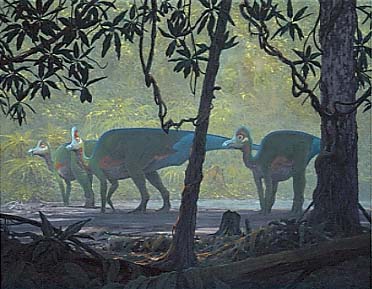Corythosaurus casuarius - Cretaceous Dinosaurs
Homepage > Cretaceous Dinosaurs - Corythosaurus casuarius
(kor-rith-oh-sor-uhss)
"helmet lizard"
Describer Brown, 1914
Also Known As --
Type of Species casuarius
Order Ornithischia
SubOrder --
InfraOrder --
Micro-Order --
SuperFamily --
Family Hadrosauridae
SubFamily Lambeosaurinae
Size 33 feet (10 meters) long
Period Late Cretaceous, 80 million years ago
Fossilsite Montana, USA; Alberta, Canada
Diet Herbivore
Corythosaurus lived during the Late Cretaceous Period 80 million years ago in what is now North America. Corythosaurus was a large herbivore dinosaur that walked on all four. It grew to 33 feet (10 meters) in length and a full grown adult weighed as much as 4 tons.
Corythosaurus was a swamp dweller, it lived at the edge of forests near water. It is believed that Corythosaurus may have lived in herds. Corythosaurus grazed on low growing plant, such as palm leaves, pine needles, and fruits.
Corythosaurus' name "helmet lizard" was given because the distinctive bony crest on top of its head, which resembles a flattened helmet. Corythosaurus had a long flat bill which it was used to graze on plants that were close to the ground. It had a toothless bill, but hundreds of small, sharp teeth grew behind it inside its jaws. When these teeth fell out, they were replaced by new ones.
Corythosaurus' skin was covered in tiny, pebbly scales that did not overlap, as in many reptiles. Its tail was flat, and it appears that its feet may have been webbed, which would have allowed the dinosaur to move around on muddy ground a little easier.
It is still not clear what the head crest may have been used for. Like other crested duck-billed dinosaurs, it was filled with nasal passages, so perhaps it functioned as a sounding device. Some scientists believe that this crest may have been colored. This colored crest may have been used in a courtship display to attract a mate. Only adult males had fully developed head crests. The crests of females and young were much smaller.

Discovery
Corythosaurus' discovery was remarkable. The dinosaur was discovered in
1912, by Barnum Brown in the Red Deer River in Alberta, Canada. The skeleton
was almost complete, and much of the dinosaur's skin had survived as a
fossil.